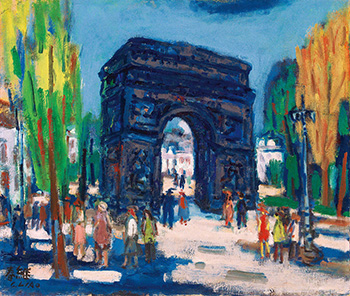PROVENANCE:
Hsieh Te-cheng, a renowned photographer, Kaohsiung, 1971(acquired directly from the artist’s family)
Ever Harvest Art Gallery, Taipei
Private collection, TaiwanEXHIBITED
10th Anniversary Memorial Exhibition of Liao Chi-chun, EverHarvest Art Gallery, Taipei, January 12 – February 9, 2002ILLUSTRATEDTaiwanese Art 123, Celebrated Art Gallery, Kaohsiung,December, 1993, color illustrated, no. 4
Centurial Rairity: Complete Works of Liao Chi-Chun, EverHarvest Art Gallery, Taipei, January 2017, color illustrated,pp. 162、451This painting is to be sold with a certificate of authenticityissued by Ever Harvest Art Gallery, Taipei.
Catalogue Note:
In June 1962, Liao Chi-chun and fellow Taiwanese artist Shiy De-jiin were invited by the U.S. State Department to undertake a study visit to the United States. The study visits for most artists would last for two months, after which the artist could choose to stay for two more months or visit other places after concluding the visit. Liao stayed in the U.S. for a total of four months. He visited world-famous museums and laid his eyes on popular abstract and expressionist paintings, learning from the works of art masters. In December, his travels took him through Europe. This rare travel experience was an eye-opener for him, and his style and use of color underwent huge changes thereafter.
After travelling through Europe and America, Liao began to create a series of city landscapes based on Athens in Greece, Venice in Italy, Toledo in Spain, Bethlehem in Israel and Paris in France. Even in the 1970s, those beautiful images still remained in his mind. In addition to painting landscapes in Taiwan, he would also sometimes paint European landscapes over the course of his work, adding his life experience and beautiful longing into his art. “Arc de Triomphe, Paris” was drawn from his memories of Paris. Created in his later years, it shows the artist’s brilliant and bold use of color in a truthful and simple composition.
The Arc de Triomphe in Paris is a world-famous landmark, and this 19th-century stone structure is always mentioned in any discussion about arches and gates. Situated at the hub of twelve Parisian boulevards, like beams of starlight focusing on a central moon, the Arc gives out a grand and magnificent air. Among Liao’s few oil paintings depicting the Paris landscape, in addition to his works on the bank of the Seine and the streetscapes, “Arc de Triomphe, Paris” is seen as his most outstanding work.
In the 1960s, Taiwan was still a conservative society with an unstable political atmosphere. When he set foot in Europe, which was open and prosperous, Liao felt the impact of completely different sights and experiences. This was particularly striking in France, a country that advocated liberty, equality and fraternity. Liao must have been delighted and excited when he drew the Arc, a symbol of victory. His trees are vivid and colorful, surrounding the steady Arc de Triomphe in the center. The artist displayed a delightful scene, as if it were a holiday, with the light blue sky, pink land, and fashionably dressed men and women on the Place Charles de Gaulle.
Liao talked about how he was inspired by his trip to Paris in an interview, “As Chagall described, he came to Paris not for learning how to paint but to be stimulated. All of these factors encouraged me to explore my own style as soon as possible.” (Excerpted from “Interview with Liao Chi-chun,” Lion Arts, Issue 29, July, 1973) It is better to see once than hear a hundred times. Liao’s artistic pilgrimage to see the thousand-year-old European civilizations, and experience French democracy and liberty, allowed him to reach his own artistic pinnacle.
Asked about his teacher’s landscape, artist A-Sun Wu indicated that, “Mr. Liao’s most frequent technique in landscapes is to use three major color blocks to distinguish the sky, earth, and buildings…” In “Arc de Triomphe, Paris,” the building was delineated with a broad brush in dark blue, demonstrating a heavy and steady air. The bright tones of the street trees and people show a vivid contrast to the building. The color in the sky and earth appears to be soft and vibrant, displaying a powerful yet harmonious world.
Under the influence of Fauvists, such as Matisse, Dufy and Ryuzaburo Umehara, Liao used bold and elaborate colors in his early works. After he was exposed to abstract art and Expressionism, his employment of color was expanded, to include a broader scope. The free flow of his brush makes his work the equal of Western masters. Although Liao regretted that he “could not continue studying in Paris” during his lifetime, he was talented enough to be called a world-class painter with his charismatic use of color.
